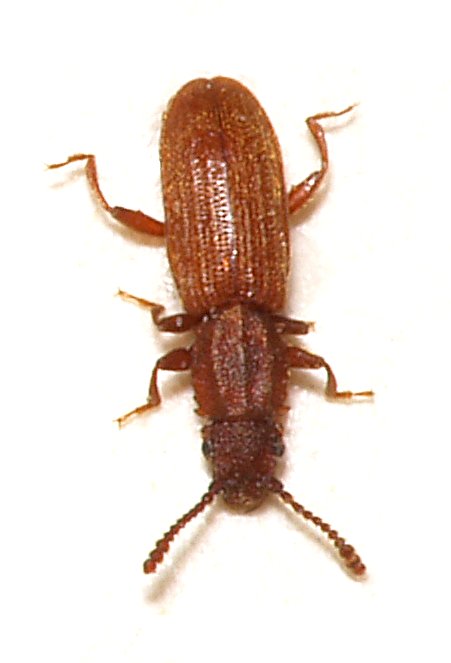SERVICE REQUEST?
Fill out the form below.
Find our nearest location
Your Local Office

Sawtoothed & Merchant Grain Beetles
Attribution: Sarefo, [GFDL or CC-BY-SA-3.0-2.5-2.0-1.0], via Wikimedia Commons
Size:
1/10 inch
Color:
Brown to dark brown
Behavior:
One female merchant or sawtoothed grain beetle may produce up to 285 eggs deposited singly or in small batches within the food. Larvae are active crawlers and move about through the food as they feed. They are scavengers and not capable of feeding on whole grains unless other insects have first attacked the kernels. After molting 2 to 4 times, the larva pupates and the adults emerge in about 7 days. The entire life cycle from egg to adult takes 27 to 50+ days, depending on the food quality and temperature. The female beetle lives from 6 to 10 months and several generations per year may occur. Large populations of these beetles can develop in short periods, forcing adults to leave infested foods seeking new food sources. They have been known to invade every package or food stored near an infested food product. Infestations, therefore, are often widespread throughout a room or area. The merchant grain beetle can fly, but the sawtoothed grain beetle cannot.
These grain beetles are two of the more commonly encountered insects in processed grain, oats, pet foods and seeds. Merchant grain beetles are found more often in foods that are high in oils and fats, such as peanuts or birdseed. Other foods attacked include rice, cereals, dried fruits, breakfast foods, grain meals, sugar, chocolate, drugs, pastas and tobacco. Its varied food preferences make it one of the most commonly encountered stored product beetles in retail food stores, warehouses and homes. In unheated grain facilities in northern states, breeding ceases at the onset of cold weather.
The control of any stored product pest involves many steps, primary of which is discovery of infested food items or other sources of infestation (e.g., food spillage accumulation). All dried food products need to be inspected for signs of infestation, including cereals, packaged dried foods (e.g., food bars and chocolate) and pet foods. Keep in mind that infested items may not always be stored in the kitchen. A common source is bags of birdseed stored in the garage or basement. Infestations have also been traced to caches of nuts and seeds accumulated by squirrels or rodents and old rodenticide baits within attics, walls and chimneys. A pest management professional can be helpful in finding difficult infestation sources. Also consider the following to prevent an infestation: · Discard infested foods in outdoor trash. Infested decorations (flowers, wreaths, etc.) should also be discarded. · Freeze suspect foods at zero degrees Fahrenheit for six days. · Clean cabinets and shelves where infested foods are stored by vacuuming and by using soap and water. · Store all dried food goods, including dried pet foods and birdseed, in a glass or plastic container with a tight lid. If beetles are in that food product then the infestation will be contained and not spread to other foods. · Consider storing cereals and similar foods in the refrigerator to limit stored product pest problems. · Consume older food products prior to newer purchases of the same food. Products purchased in larger quantities (e.g., from a wholesale food warehouse) are more likely to become an infestation source if these are stored for long periods of time – especially if they are not stored in containers with tight-fitting lids.
Family Name:
Oryzaephilus surinamensis oryzaephilus mercator
Read What Our Clients
Are Saying
My Terminix tech Scott is the best! He is professional, courteous and absolutely thorough about his job. Thank you for sending such a blessed tech to my house. Hamlet, NC
This letter is to say how pleased we are here at Morreene West Apartments with your services. We are very pleased with the technician, Christopher. He does a great job. Durham, NC
Terminix has consistently offered our apartment complex reliable, competent service. We are completely satisfied with their knowledgeable representative who is always punctual and does a superior job for us every time. Chapel Hill, NC
I would like to take the time to thank you for giving us such great service here at Carver Pond Apartments. Your Pest Technician Christopher Mitchell has provided us with excellent service over the last few months. Christopher is such a great help to us in providing helpful information so that we can better serve our residents here at Carver Pond. Durham, NC
SERVICE REQUEST?
Fill out the form below.